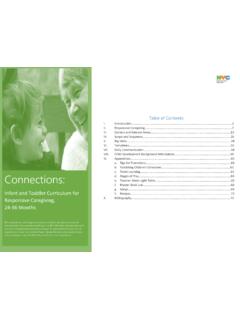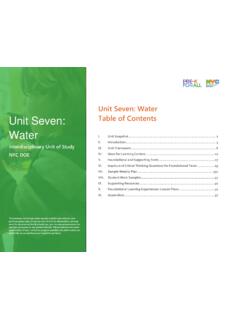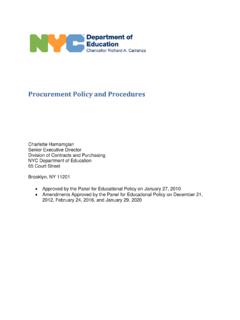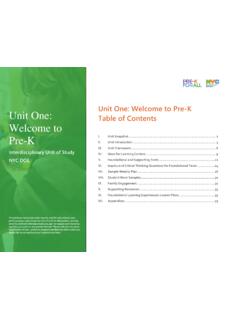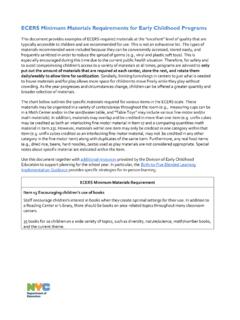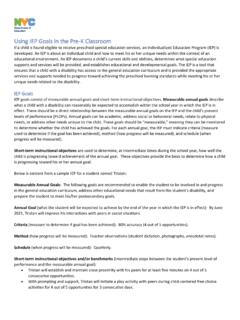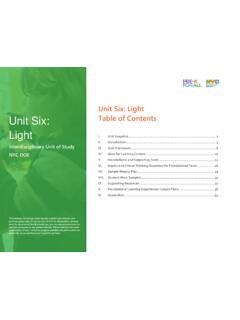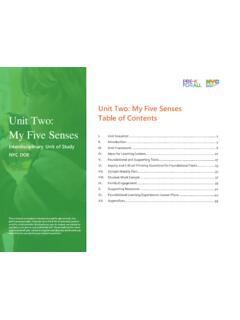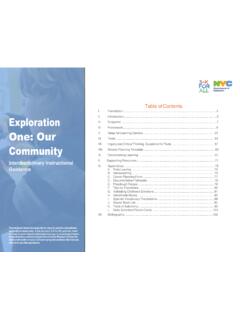Transcription of Exploration Two: Our Environment
1 Exploration Two: Our Environment Interdisciplinary Instructional Guidance EXPLORE The enclosed instructional guidance may be used for educational, non -profit purposes only. If you are not a 3 -K for All provider, send an email to to request permission to use this document or an y portion thereof. Please indicate the 1 name and location of your sc hool or program and describe how you intend to use this guidance. Table of Contents I. Foundation2 II. Introduction 5 III. Snapshot6 IV. Framework7 V. Id eas for Learning Centers72 VI. Texts 99 VII. Inquiry and Critical Thinking Questions for Texts102 VIII. Weekly Planning Template106 IX. Documenting Learning111 X. Supporting Resources116.
2 XI. Appendices 118 A. Loose Parts 118 B. Recipes119 C. Learning Center Picture Samples 121 ..D. Supporting Emergent Multilingual Learners 122 E. Talking to Children about Disabilities124 F. Spanish Vocabulary Translations126 G. Center Planning Form127 H. Documentation Template 128 I. Master Book List129 I. Foundation References: Gopnik, A. (2009). The Philosophical Baby: What Children s Minds Tell Us About Truth, Love and the Meaning of Life. New York: Picador Lieberman, A. (1993). The Emotional Life of the toddler . New York: The Free Press Neville, H. (2007). Is This a Phase: Child Development & Parenting Strategies, Birth to 6 Years. Washington: Parenting Press 2 Explorations: Comprehensive, In-depth Learning Across Domains New York City 3-K for All Interdisciplinary Explorations are designed to connect children, families and teaching staff and invite them to engage in comprehensive, in-depth, play-based learning across domains.
3 The three Explorations are designed to be implemented over the course of the ten-month program year. Topics and activities in the Explorations begin with routines and learning about the classroom and progress to more abstract ideas throughout the year. Explorations are grounded in research on developmental expectations as described in the Head Start Early Learning Outcomes Framework: Ages Birth to Five (ELOF), which outlines the skills, behaviors and concepts programs foster as they engage with our youngest learners. By using the three Explorations as written, programs will support all of the preschool goals included in the framework. Teaching staff should refer to the ELOF and their authentic assessment system when implementing Explorations in order to connect their observations of each child with ELOF goals, developmental progressions and indicators and to guide their planning as they work to meet the needs of each child in the class.
4 Guiding Principles of the Early Learning Outcomes Framework: Each child is unique and can succeed. Children are individuals with different rates and paths of development. Each child is uniquely influenced by their prenatal envi ronment, temperament, physiology, and life experiences. With the appropriate support, all children can be successful learners and achieve the skills, behaviors, and knowledge described in the Framework. Learning occurs within the context of relationships. Caring families, teachers, and other adults matter in a young child's life. Responsive and supportive interactions with adults are essential to children's learning. Families are children's first and most important caregivers, teachers, and advocates. Families must be respected and supported as the primary influence in their child's early learning and education.
5 Their knowledge, skills, and cultural backgrounds contribute to children's school readiness. Children learn best when they are emotionally and physically safe and secure. Nurturing, responsive, and consistent care helps create safe environments where children feel secure and valued. In these settings, children are able to engage fully in learning experiences. Areas of development are integrated, and children learn many concepts and skills at the same time. Any single skill, behavior, or ability may involve multiple areas of development. For example, as infants gain fine motor skills, they can manipulate objects in new ways and deepen their understanding of cause and effect. As preschoolers gain new verbal skills, they can better manage their emotions and form more complex friendships.
6 Teaching must be intentional and focused on how children learn and grow. Children are active, engaged, and eager learners. Good teaching practices build on these intrinsic strengths by providing developmentally appropriate instruction and opportunities for Exploration and meaningful play. Every child has diverse strengths rooted in their family's culture, background, language, and beliefs. Responsive and respectful learning environments welcome children from diverse cultural and linguistic backgrounds. Effective teaching practices and learning experiences build on the unique backgrounds and prior experiences of each child. Click here to access the Guiding Principles of the Head Start Early Learning Outcomes Framework online 3 Early Learning Outcomes Framework Domain Organization Click here to access the interactive ELOF 4 II.
7 Introduction Welcome to Exploration Two: Our Environment . This Exploration is the second in a series of three 3-K for All Interdisciplinary Instructional Guidance materials. In this Exploration we expand the focus beyond the classroom community as studied in Exploration One to i nclude the Environment surrounding the 3-K for All program. Exploration Two: Our Environment is designed to be implemented over the course of about four months. In month one, begin by encouraging children to observe the world around them, noting what they see in their Environment . Around age three, children are often interested in looking at the world around them, and in this Exploration , you have the opportunity to foster their interest and provide them with the time and space to look carefully at their surroundings.
8 In month two, encourage children to build on their observations and begin to think critically about the things around them. Move from highlighting what children see, to encouraging them to investigate and learn more about these things. In this month, encourage children to make predictions, test hypotheses, and to make and share conclusions. After noticing and investigating, help children take a pointed look at some specific aspects of their Environment . In month three, children are encouraged to observe and investigate the buildings and structures around them. In month four, children examine and explore objects in their Environment that move. As we move to examining our Environment , keep in mind that learning occurs through the context of relationships and that children s positive connections with you are key to learning and successful implementation of this and each Exploration .
9 Not only are your connections with the children in your class essential, but the connections you make between the big ideas in this Exploration (Seeing, Investigating, Building and Moving) are also crucial. Be thoughtful and intentional about how you help children develop their observational and investigative skills and then use these skills to explore the world around them. As we move to examining our Environment , keep in mind that learning occurs through the context of relationships and that children s positive connections with you are key to learning and successful implementation of this, and each Exploration . When you give children the opportunity to notice their surroundings and you attend to their observations, you also have the opportunity to learn more about each child. Pay close attention to their interests and think carefully about how you can use this information to tailor opportunities for them to explore their surroundings.
10 Within each of the four big ideas in this Exploration there is space to build on specific interests of the children and focus on content that is most relevant to them. For example, if children seem to notice and express interest in taxis in month one (Seeing), invite children to investigate them further in month two (Investigating) then use month three (Building) to investigate parking structures and/or taxi garages and month four (Moving) to delve into understanding how taxis move. In noting things the children can see, and ways things and people move, questions about people with disabilities may arise. Please see Section XI: Appendices for guidance on how to discuss this with children. Additionally, keep your partnership with families in mind throughout implementation. Share your observations with them, invite them to share with you and suggest activities they can do to help connect children s experiences in and out of the classroom.
